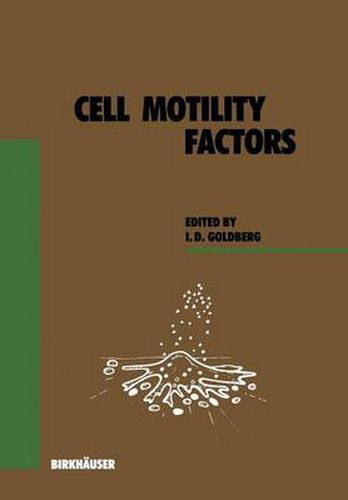Readings Newsletter
Become a Readings Member to make your shopping experience even easier.
Sign in or sign up for free!
You’re not far away from qualifying for FREE standard shipping within Australia
You’ve qualified for FREE standard shipping within Australia
The cart is loading…






This title is printed to order. This book may have been self-published. If so, we cannot guarantee the quality of the content. In the main most books will have gone through the editing process however some may not. We therefore suggest that you be aware of this before ordering this book. If in doubt check either the author or publisher’s details as we are unable to accept any returns unless they are faulty. Please contact us if you have any questions.
Cell motility is an important component of many basic physiologic and pathologic processes. Understanding mechanisms of cell motility is therefore essential to the development of new research and clinical approaches in biomedical research. In the early phases of embryogenesis, prepreogrammed morpho- genetic movement determines normal development. The migration of the neural crest cells, for example, is responsible for the establishment of almost the entire peripheral nervous system, the proper positioning of the epinephrine-secreting cells in the adrenal gland and the deposition of pigment cells in the skin (Newgreen and Erikson, 1986). Any distur- bance or deviation from this complex migration pattern results in serious malformations. The embryonic cells are stimulated to migrate by internal signals as well as by signals from adjacent cells. Various stimulatory and inhibitory mechanisms are likely to operate during this dynamic process. However, once morphogenesis is achieved, most so- matic cells tend to remain stationary, and the motile phenotype is dormant. Under certain physiologic and pathologic conditions, however, cells re-express their motile phenotype and migrate. In wound healing and angiogenesis cell migration and proper three-dimensional positioning is critical. Endothelial cell migration following luminal injury is another homeostatic mechanism which helps prevent vascular lesions (Reidy and Silver, 1985; Sholley et aI., 1977; Wong and Gottlieb, 1988). In pathological conditions such as atherosclerosis, smooth muscle cell migration through the internal elastic lamina to the luminal surface may be the initial event leading to the development of the atherosclerotic plaque (Goldberg, 1982).
$9.00 standard shipping within Australia
FREE standard shipping within Australia for orders over $100.00
Express & International shipping calculated at checkout
This title is printed to order. This book may have been self-published. If so, we cannot guarantee the quality of the content. In the main most books will have gone through the editing process however some may not. We therefore suggest that you be aware of this before ordering this book. If in doubt check either the author or publisher’s details as we are unable to accept any returns unless they are faulty. Please contact us if you have any questions.
Cell motility is an important component of many basic physiologic and pathologic processes. Understanding mechanisms of cell motility is therefore essential to the development of new research and clinical approaches in biomedical research. In the early phases of embryogenesis, prepreogrammed morpho- genetic movement determines normal development. The migration of the neural crest cells, for example, is responsible for the establishment of almost the entire peripheral nervous system, the proper positioning of the epinephrine-secreting cells in the adrenal gland and the deposition of pigment cells in the skin (Newgreen and Erikson, 1986). Any distur- bance or deviation from this complex migration pattern results in serious malformations. The embryonic cells are stimulated to migrate by internal signals as well as by signals from adjacent cells. Various stimulatory and inhibitory mechanisms are likely to operate during this dynamic process. However, once morphogenesis is achieved, most so- matic cells tend to remain stationary, and the motile phenotype is dormant. Under certain physiologic and pathologic conditions, however, cells re-express their motile phenotype and migrate. In wound healing and angiogenesis cell migration and proper three-dimensional positioning is critical. Endothelial cell migration following luminal injury is another homeostatic mechanism which helps prevent vascular lesions (Reidy and Silver, 1985; Sholley et aI., 1977; Wong and Gottlieb, 1988). In pathological conditions such as atherosclerosis, smooth muscle cell migration through the internal elastic lamina to the luminal surface may be the initial event leading to the development of the atherosclerotic plaque (Goldberg, 1982).